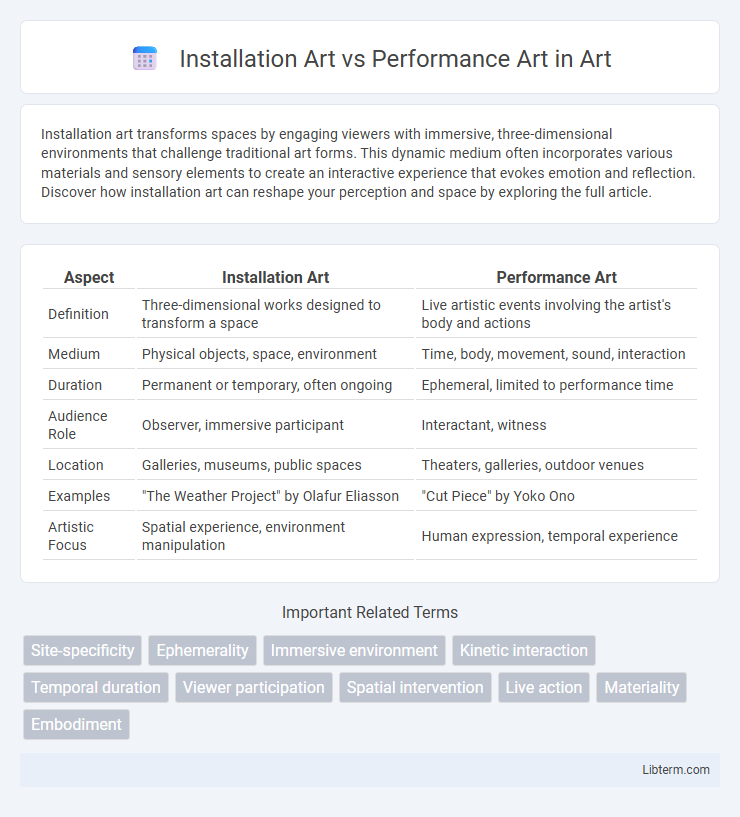Installation art transforms spaces by engaging viewers with immersive, three-dimensional environments that challenge traditional art forms. This dynamic medium often incorporates various materials and sensory elements to create an interactive experience that evokes emotion and reflection. Discover how installation art can reshape your perception and space by exploring the full article.
Table of Comparison
| Aspect | Installation Art | Performance Art |
|---|---|---|
| Definition | Three-dimensional works designed to transform a space | Live artistic events involving the artist's body and actions |
| Medium | Physical objects, space, environment | Time, body, movement, sound, interaction |
| Duration | Permanent or temporary, often ongoing | Ephemeral, limited to performance time |
| Audience Role | Observer, immersive participant | Interactant, witness |
| Location | Galleries, museums, public spaces | Theaters, galleries, outdoor venues |
| Examples | "The Weather Project" by Olafur Eliasson | "Cut Piece" by Yoko Ono |
| Artistic Focus | Spatial experience, environment manipulation | Human expression, temporal experience |
Defining Installation Art
Installation art transforms spaces by integrating physical elements into immersive environments that engage viewers spatially and sensorially. It emphasizes the relationship between the artwork, the surrounding space, and the audience's experience, often incorporating mixed media, found objects, and technology. Unlike performance art, which centers on live actions and temporality, installation art prioritizes spatial narrative and interactive presence within a defined physical context.
Understanding Performance Art
Performance Art emphasizes live, time-based actions where the artist's body serves as the primary medium, creating an immersive experience that challenges traditional art boundaries. It often incorporates elements of theater, dance, and visual art to convey ideas, emotions, or social commentary directly to the audience. This art form prioritizes presence, interaction, and ephemerality, distinguishing it from Installation Art, which centers on creating spatial environments or physical artworks.
Historical Origins and Evolution
Installation Art emerged in the early 20th century, rooted in Dada and Surrealism movements, emphasizing spatial environments and viewer interaction, evolving through Marcel Duchamp's readymades to contemporary immersive experiences. Performance Art originated in the 1960s as a fusion of visual art and theater, with pioneers like Marina Abramovic and Allan Kaprow using the artist's body as the medium to challenge traditional art forms and social norms. Both art forms evolved through the 20th century by expanding boundaries, incorporating multimedia, and emphasizing temporality and participation.
Key Characteristics of Installation Art
Installation art immerses viewers in a three-dimensional environment that transforms the perception of space, often integrating various materials such as found objects, video, sound, and light to create a multisensory experience. It emphasizes spatial relationships, inviting audience interaction or contemplation within the constructed setting, blurring the boundaries between artwork and surroundings. Unlike performance art, which centers on live actions and temporal processes, installation art maintains a physical presence that alters the viewer's spatial context over extended periods.
Essential Elements in Performance Art
Performance Art emphasizes the artist's live presence, body movement, and time-based actions as essential elements, creating an ephemeral experience that often involves audience interaction. Unlike Installation Art, which centers on physical space and objects, Performance Art relies on theatricality, choreography, and improvisation to convey meaning in real-time. The immediacy and transience of Performance Art challenge traditional art boundaries by integrating visual, auditory, and kinesthetic stimuli into a singular, momentary event.
Audience Engagement: Passive vs. Active
Installation Art often invites the audience to explore and interpret the space passively, as viewers navigate through or around the artwork, absorbing its sensory and spatial elements. Performance Art requires active participation or interaction, demanding physical or emotional involvement from the audience to complete the experience. This contrast highlights Installation Art's immersive environments versus Performance Art's dynamic, real-time audience engagement.
Space, Time, and Context in Both Forms
Installation art transforms physical space by immersing viewers in a three-dimensional environment, emphasizing spatial interaction and permanence within a specific location. Performance art prioritizes temporal experience, unfolding actions over time and often relying on live presence and audience engagement, making context and moment crucial for its meaning. Both forms challenge traditional art boundaries by incorporating environment and temporality, but installation art anchors itself in spatial context while performance art exists primarily within temporal and social conditions.
Major Artists and Influential Works
Installation Art features artists like Yayoi Kusama, known for her immersive Infinity Mirror Rooms that blend space and perception. Performance Art is exemplified by Marina Abramovic, whose work "The Artist is Present" explores endurance and audience interaction through live presence. Both genres push boundaries, with installation emphasizing spatial experience and performance centering on temporal, body-based expression.
Common Themes and Conceptual Approaches
Installation Art and Performance Art both explore themes of temporality, space, and audience interaction, challenging traditional art boundaries by emphasizing experience over static form. They prioritize conceptual approaches that engage viewers in immersive environments or live actions, fostering a dynamic relationship between art, context, and perception. Both practices often address social, political, and cultural narratives, using multisensory elements to evoke emotional and intellectual responses.
Installation Art vs Performance Art: Future Trends
Installation art is evolving through immersive technologies such as augmented reality (AR) and virtual reality (VR), enabling dynamic, interactive environments that engage multiple senses. Performance art increasingly integrates digital platforms and live streaming, expanding its reach beyond physical venues by incorporating real-time audience interaction globally. Both mediums emphasize experiential depth and interactivity, with future trends converging toward hybrid works that blend spatial installations and performative elements using advanced digital tools.
Installation Art Infographic

 libterm.com
libterm.com